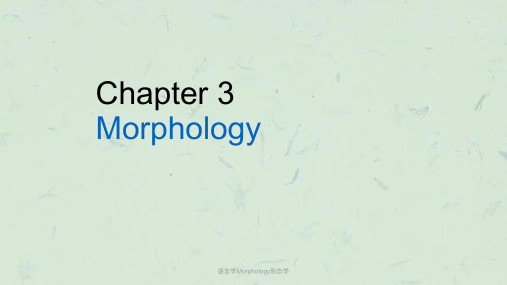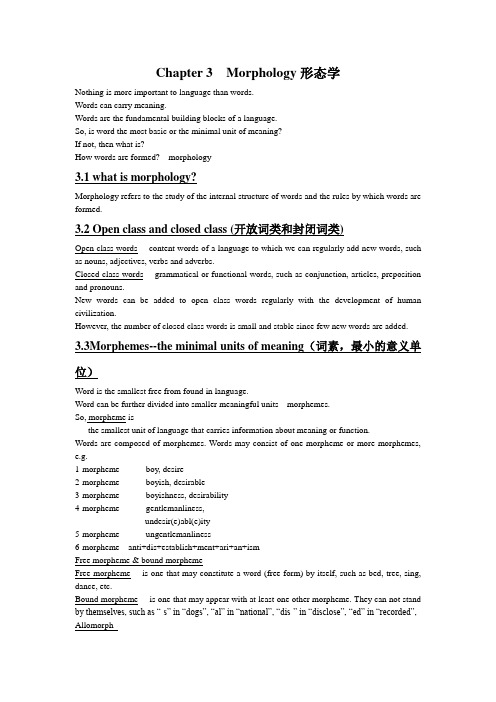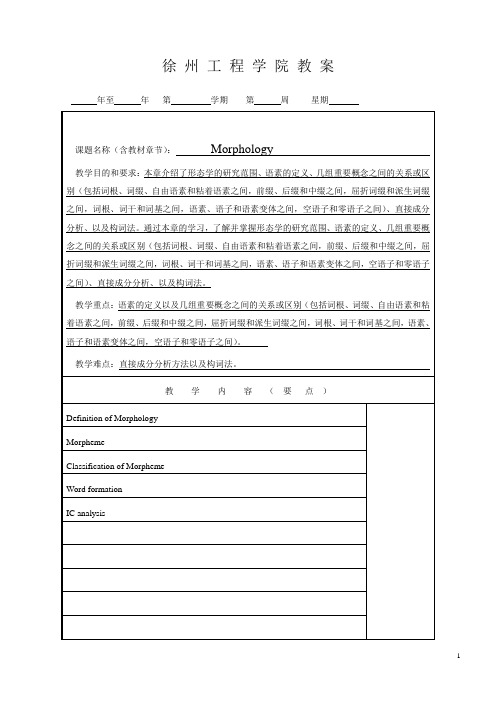英语语言学2 Morphology形态学word讲义
英语语言学之Morphology PPT课件

授课题目 : morphology.
1
教学目标及基本要求:Teaching target and object
(1) Let students know what morphology is, and how the morphemes are combined into larger units for human communication.
16
Unbearable Watchful Soft-hearted
uneducated inspiring horsemanship
17
See the exercises 1 and 2 on page 82
18
1) un- + bear + -able 2) watch + -ful 3) person+ -ify (i) + -cation 4) un- + exception + -al + -ly 5) un- +educate +-(e)d 6) inspir(e) + -ing 7) soft + heart + -ed 8) horse + man + -ship
A word is “a minimum free form”, that is , the smallest form that can occur by itself.
8
The four characteristics of a word
A word is a sound or combination of sounds which we produce voluntarily with our vocal equipment.e.g. “we” [wi:]
语言学Morphology形态学课件

3) A grammatical unit:
sentence clause phrase word morpheme
语言学Morphology形态学
1.2 Identification of words
1) Stability: the constituent parts of a complex word cannot be rearranged
语言学Morphology形态学
3) A minimum free form: the smallest unit that can constitute a complete utterance by itself, e.g.
• --Is Jane coming tonight? --Possibly.
sentence together (function words).
语言学Morphology形态学
3) Closed-class words vs. open-class words: Closed-class: a word whose membership is fixed or limited. New
chairman﹡manchair
The chairman looked at the audience. The audience looked at the chairman. 2) Relative uninterruptibility: New elements cannot be inserted into a word even when there are several parts in a word. disappointment dis + appoint + ment Paul, (Jane) and Rebecca are my classmates.
Unit 2 Morphology

Unit 2 MorphologyThe morpheme is the smallest meaningful linguistic unit of language, not divisible or analyzable into smaller forms.The phonetic or orthographic strings or segments which realize morphemes are termed ‘morphs’. Morphs are actual spoken, minimal carriers of meaning.An allomorph is one of the variants of the same morpheme.An allomorph refers to a member of a set of morphs, which represent one morpheme.A morpheme is composed by phoneme(s) (the smallest linguistically distinctive units of sound) in spoken language, and by grapheme(s) (the smallest units of written language) in written language Note that any language has a register of morphemes, the physical realizations of which are called morphs. Several morphs that belong to the same morpheme are also called allomorphs Classifications of morphemesFree vs. bound morphemes in terms of their capacity of occurring alone 自由语素与粘着语素e.g., man, wind, open, tour粘着语素不能独立成词,只能依附于其他语素上以构成词或担当一定的语法功能。
语言学Morphology形态学课件

chairman﹡manchair
The chairman looked at the audience. The audience looked at the chairman. 2) Relative uninterruptibility: New elements cannot be inserted into a word even when there are several parts in a word. disappointment dis + appoint + ment Paul, (Jane) and Rebecca are my classmates.
语言学Morphology形态学
1. Word
Word: a unit of expression that has universal intuitive recognition by native-speakers, whether spoken or written
1.1 Three senses of “word”: 1) A physically definable unit:
members are not regularly added. Pronouns, prepositions, conjunctions, articles, etc. Open-class: A word whose membership is in principle infinite or unlimited. Nouns, verbs, adjectives, adverbs Note: The distinction is not quite as clear-cut as it seems. Prepositions: regarding, throughout, out of, according to, with regard to, in spite of, be means of ; Auxiliary verbs
英语语言学2 Morphology形态学word讲义

Chapter 3 Morphology形态学Nothing is more important to language than words.Words can carry meaning.Words are the fundamental building blocks of a language.So, is word the most basic or the minimal unit of meaning?If not, then what is?How words are formed?---morphology3.1 what is morphology?Morphology refers to the study of the internal structure of words and the rules by which words are formed.3.2 Open class and closed class (开放词类和封闭词类)Open class words----content words of a language to which we can regularly add new words, such as nouns, adjectives, verbs and adverbs.Closed class words----grammatical or functional words, such as conjunction, articles, preposition and pronouns.New words can be added to open class words regularly with the development of human civilization.However, the number of closed class words is small and stable since few new words are added.3.3Morphemes--the minimal units of meaning(词素,最小的意义单位)Word is the smallest free from found in language.Word can be further divided into smaller meaningful units---morphemes.So, morpheme is---the smallest unit of language that carries information about meaning or function.Words are composed of morphemes. Words may consist of one morpheme or more morphemes, e.g.1-morpheme boy, desire2-morpheme boyish, desirable3-morpheme boyishness, desirability4-morpheme gentlemanliness,undesir(e)abl(e)ity5-morpheme ungentlemanliness6-morpheme anti+dis+establish+ment+ari+an+ismFree morpheme & bound morphemeFree morpheme----is one that may constitute a word (free form) by itself, such as bed, tree, sing, dance, etc.Bound morpheme----is one that may appear with at least one other morpheme. They can not stand by themselves, such as ―-s‖ in ―dogs‖, ―al‖ in ―national‖, ―dis-‖ in ―disclose‖, ―ed‖ in ―recorded‖, AllomorphSome morphemes have a single form in all contexts, such as ―dog, bark, cat‖,etc.In other instances, there may be some variation, that is, a morpheme may have alternate shapes or phonetic forms. They are said to be the allomorphs of the morpheme.the plural morpheme may be represented by:map----maps [s]dog----dogs [z]watch----watches [iz]mouse----mice [ai]ox----oxen [n]tooth----teethsheep----sheepEach of the underlined part is called an allomorph of plural morpheme.3.4 Analyzing word structuresIdentify each of the major component morphemes.Classify these morphemes in terms of their contribution to the meaning and function of the larger word.Generally speaking, a complex word often consists of a root and one or more affixes.Root: constitutes the core of the word and carries the major component of its meaning.Roots typically belong to lexical categories such as nouns, verbs, adjectives and prepositions. Affix: is always a bound morpheme, and does not belong to a lexical category.Tree diagram (teach-er)NV Afteach er3.5 Derivational morpheme & inflectional morpheme 派生词素和屈折词素Derivational morphemes---- the morphemes which change the category, or grammatical class of words, e.g. modern---modernize, length---lengthen, fool---foolish, etc.when derivational morphemes are conjoined to other morphemes, a new word is derived or formed--- may change grammatical classeg. light –lighten; nasal –nasalize;eat—edible; grave--engrave--- may not change grammatical classeg. net---internet; happy—unhappy;national—multinational; terror-terroristMany prefixes and suffixes belong to derivational morphemeseg. tele-phone; music-ianConsider: is there any prefix or suffix which doesn’t fall into derivational morphemes? Inflectional morphemes---- the morphemes which are for the most part purely grammatical markers, signifying such concepts as tense, person, mood, voice, case, number, aspect and degree;e.g.:1) number: tables apples cars2) tense: talk/talks/talking/talked3) case: John/John’s4) degree: large/larger/largestInflectional morphemes never change lexical category, never add any lexical meaning,Morphemefree morpheme bound morphemefree root affix bound root (-ceive)derivational morpheme inflectional morphemeprefix suffixproductive morphological rulesSome of the rules can be used quite freely to form new wordseg. un + derived words (adj.) = not ---adj. [un-Rule]unimaginable unthinkable; unmentionedunbrave (×)(un-rule more productive for adj. derived from verbs than for adj. of just one morpheme like sad---unsad??)eg. sincere---sincerity; scarce—scarcity [ity –Rule]fierce---fiercity (×)(ity-Rule becomes less productive than before)Word-formationDerivation派生: the most common word-formation process, by affixationeg. Derivational + free morphemesgirlish; reliableCompounding复合(stringing words together; juxtaposition of two or more than two words to form a new, composite one with distinct properties of its own)Adj. N. V. Prep. Adj. Bittersweet clearway whitewash blackoutN. Headstrong rainbow spoon-feed head-onV. Carryall pickpocket sleepwalk cutupPrep. Inborn off-licence undertake withoutSome points about compounds1) two words in the same grammatical category, compound in this category;eg. landlord; bedroom; icy-cold;2) two words in different categories, compound in the class of second or final word;eg. pickpocket; headstrong; blackboard; swearwordcompound with preposition, nonpreposition part decideseg. undertake; uplift; overtake; oversee; overdoseexceptions: blackout ( n.) ; head-on (adv.);3) compounds have different stress patterns from non-compounded word sequence;e.g. 'blackbird & black 'bird;'washing machine'greenhouse & green 'house;red 'coat &'redcoat4) meaning of a compound not necessarily the sum of the meaning of its partsmeaning of each compound includes at least to some extent the meaning of individual partseg. reading room; a falling star; a looking glass (窥镜)meanings of compounds do not relate to the meanings of the individual parts at alleg. bigwig(要人,大亨); greenhorns (生手,不懂世故的人)highbrow(知识分子,自命不凡的人)/lowbrow(教养浅薄的人);turncoat变节者Conversion 转类构词(a change in the grammatical function of a word without adding or removing any part of it)Eg. a walk---to walk; a play---to playincrease (n.)--- increase (v.)conduct (n.) --- conduct (v.)I have no knowledge of the political dos and don’tsBackformation 反向构词(a reverse process of affixation. The word is not formed by adding a morpheme to a stem but by assuming a part of the stem as a suffix and removing it)Eg. editor --- edit; beggar --- begtelevision – televise; enthusiasm--- enthuseBorrowing外来语构词(adopting foreign words)--- loan-words借词(retaining their original phonetic or even written forms)eg. bungalow (Hindi); spaghetti (Italian);veranda (Portuguese 阳台)bok choy (Chinese baice); alcohol (Arabic)--- loan-translation or calques(直译,译借) 仿造词( a direct translation of the foreign word into English)eg. superman ---Ubermensch (German)Kongfu (Chinese)Clipping缩略构词( a reduction process in which a word of more than one syllable is reduced to a shorter form, often used in informal speech)Eg. ad--- advertisement; lab---laboratoryfan---fanatic; flu---influenza;math---mathematicsBlending混合构词(join the beginning of the first word to the end of the other words)Eg. smog (smoke + fog)brunch (breakfast + lunch)motel (motor + hotel)telecast (television + broadcast)Acronym首字构词(string together the initial letters of the words in a phrase, typically the names of technical apparatus and institutions, sometimes, the phrasal origin is lost )Eg. radar (radio detecting and ranging)AIDS (acquired immune deficiency syndrome)SARS (Severe Acute Respiratory Syndrome)APEC (Asia-Pacific Economic Cooperation)UNESCO (United Nations Educational, Scientific, and Cultural Organization)Coinage 创新构词(invention of totally new terms, least common, often brand names)eg. xerox; nylon; kleenex(面巾纸)ConclusionsMorphological rules provide means for forming new words, or coin new words (eg. hair spray, tea ceremony, space walk, etc.)Morphological rules may be productive or less productive (un-Rule) ;may become less productive with the passage of time (ity-Rule)。
英语语言学名词解释

英语语言学名词解释
英语语言学是语言学中的一个分支,研究英语的语言结构、语音、语法、语义、语用和历史演变等方面。
以下是一些英语语言学的名词解释:
1. Phonetics(音韵学):研究语音、发音和声音的学科。
它包括语音学和音系学。
2. Phonology(音系学):研究语音在语言中的系统性组织和规律性变化的学科。
3. Morphology(形态学):研究词形变化和词构成的学科。
4. Syntax(句法学):研究句子结构和语法规则的学科。
5. Semantics(语义学):研究语言意义的学科,包括词义和句子意义。
6. Pragmatics(语用学):研究语言在实际使用中的含义和功能的学科。
7. Discourse analysis(语篇分析):研究语言在实际使用中的连贯性和语篇结构的学科。
8. Historical linguistics(历史语言学):研究语言的演变和变化的学科。
9. Sociolinguistics(社会语言学):研究语言和社会、文化、地理和历史等因素之间的关系的学科。
10. Psycholinguistics(心理语言学):研究语言和心理过程之间的关系的学科,包括语言习得、记忆和理解等。
以上是一些常见的英语语言学名词解释,它们涵盖了英语语言学的主要领域和分支。
英语语言学概论Morphology形态学

英语语言学概论Morphology形态学
• Bound morphemes(粘着词素): those that can not occur alone as separate words.-ful, -less, re- de, tele-vis-ion, un-happy
• blackboard=black+board • disagree=dis +agree • 2 meaningful: can not be further
divided without destroying its meaning • cap+tain, man+age==manage
英语语言学概论Morphology形态学
Chapter 5 Morphology(形态学, 词法学)
Internal structures of words and rules of word formation
英语语言学概论Morphology形态学
careful wonderful successful beautiful widen deepen shorten fasten sharpen Impossible, incorrect, improper, illegal, report, import export transport support porter respect inspect expect suspect prospect boys girls toys books tables bottles working, thinking speaking, cutting, hitting the, to,for,bird, leg, air, captain. suffixes,prefixes,roots,inflectional suffixes,free root
英语语言学概论morphology

年至年第学期第周星期
课题名称(含教材章节):Morphology
教学目的和要求:本章介绍了形态学的研究范围、语素的定义、几组重要概念之间的关系或区别(包括词根、词缀、自由语素和粘着语素之间,前缀、后缀和中缀之间,屈折词缀和派生词缀之间,词根、词干和词基之间,语素、语子和语素变体之间,空语子和零语子之间)、直接成分分析、以及构词法。通过本章的学习,了解并掌握形态学的研究范围、语素的定义、几组重要概念之间的关系或区别(包括词根、词缀、自由语素和粘着语素之间,前缀、后缀和中缀之间,屈折词缀和派生词缀之间,词根、词干和词基之间,语素、语子和语素变体之间,空语子和零语子之间)、直接成分分析、以及构词法。
教学重点:语素的定义以及几组重要概念之间的关系或区别包括词根、词缀、自由语素和粘着语素之间,前缀、后缀和中缀之间,屈折词缀和派生词缀之间,词根、词干和词基之间,语素、语子和语素变体之间,空语子和零语子之间)。
教学难点:直接成分分析方法以及构词法。
教学内容(要点)
Definition of Morphology
Morpheme
Classification of Morpheme
Word formation
IC analysis
徐州工程学院教案纸
5. Orthographic change (拼写变化): Changes at the graphic level
- 1、下载文档前请自行甄别文档内容的完整性,平台不提供额外的编辑、内容补充、找答案等附加服务。
- 2、"仅部分预览"的文档,不可在线预览部分如存在完整性等问题,可反馈申请退款(可完整预览的文档不适用该条件!)。
- 3、如文档侵犯您的权益,请联系客服反馈,我们会尽快为您处理(人工客服工作时间:9:00-18:30)。
Chapter 3 Morphology形态学Nothing is more important to language than words.Words can carry meaning.Words are the fundamental building blocks of a language.So, is word the most basic or the minimal unit of meaning?If not, then what is?How words are formed?---morphology3.1 what is morphology?Morphology refers to the study of the internal structure of words and the rules by which words are formed.3.2 Open class and closed class (开放词类和封闭词类)Open class words----content words of a language to which we can regularly add new words, such as nouns, adjectives, verbs and adverbs.Closed class words----grammatical or functional words, such as conjunction, articles, preposition and pronouns.New words can be added to open class words regularly with the development of human civilization.However, the number of closed class words is small and stable since few new words are added.3.3Morphemes--the minimal units of meaning(词素,最小的意义单位)Word is the smallest free from found in language.Word can be further divided into smaller meaningful units---morphemes.So, morpheme is---the smallest unit of language that carries information about meaning or function.Words are composed of morphemes. Words may consist of one morpheme or more morphemes, e.g.1-morpheme boy, desire2-morpheme boyish, desirable3-morpheme boyishness, desirability4-morpheme gentlemanliness,undesir(e)abl(e)ity5-morpheme ungentlemanliness6-morpheme anti+dis+establish+ment+ari+an+ismFree morpheme & bound morphemeFree morpheme----is one that may constitute a word (free form) by itself, such as bed, tree, sing, dance, etc.Bound morpheme----is one that may appear with at least one other morpheme. They can not stand by themselves, such as ―-s‖ in ―dogs‖, ―al‖ in ―national‖, ―dis-‖ in ―disclose‖, ―ed‖ in ―recorded‖, AllomorphSome morphemes have a single form in all contexts, such as ―dog, bark, cat‖,etc.In other instances, there may be some variation, that is, a morpheme may have alternate shapes or phonetic forms. They are said to be the allomorphs of the morpheme.the plural morpheme may be represented by:map----maps [s]dog----dogs [z]watch----watches [iz]mouse----mice [ai]ox----oxen [n]tooth----teethsheep----sheepEach of the underlined part is called an allomorph of plural morpheme.3.4 Analyzing word structuresIdentify each of the major component morphemes.Classify these morphemes in terms of their contribution to the meaning and function of the larger word.Generally speaking, a complex word often consists of a root and one or more affixes.Root: constitutes the core of the word and carries the major component of its meaning.Roots typically belong to lexical categories such as nouns, verbs, adjectives and prepositions. Affix: is always a bound morpheme, and does not belong to a lexical category.Tree diagram (teach-er)NV Afteach er3.5 Derivational morpheme & inflectional morpheme 派生词素和屈折词素Derivational morphemes---- the morphemes which change the category, or grammatical class of words, e.g. modern---modernize, length---lengthen, fool---foolish, etc.when derivational morphemes are conjoined to other morphemes, a new word is derived or formed--- may change grammatical classeg. light –lighten; nasal –nasalize;eat—edible; grave--engrave--- may not change grammatical classeg. net---internet; happy—unhappy;national—multinational; terror-terroristMany prefixes and suffixes belong to derivational morphemeseg. tele-phone; music-ianConsider: is there any prefix or suffix which doesn’t fall into derivational morphemes? Inflectional morphemes---- the morphemes which are for the most part purely grammatical markers, signifying such concepts as tense, person, mood, voice, case, number, aspect and degree;e.g.:1) number: tables apples cars2) tense: talk/talks/talking/talked3) case: John/John’s4) degree: large/larger/largestInflectional morphemes never change lexical category, never add any lexical meaning,Morphemefree morpheme bound morphemefree root affix bound root (-ceive)derivational morpheme inflectional morphemeprefix suffixproductive morphological rulesSome of the rules can be used quite freely to form new wordseg. un + derived words (adj.) = not ---adj. [un-Rule]unimaginable unthinkable; unmentionedunbrave (×)(un-rule more productive for adj. derived from verbs than for adj. of just one morpheme like sad---unsad??)eg. sincere---sincerity; scarce—scarcity [ity –Rule]fierce---fiercity (×)(ity-Rule becomes less productive than before)Word-formationDerivation派生: the most common word-formation process, by affixationeg. Derivational + free morphemesgirlish; reliableCompounding复合(stringing words together; juxtaposition of two or more than two words to form a new, composite one with distinct properties of its own)Adj. N. V. Prep. Adj. Bittersweet clearway whitewash blackoutN. Headstrong rainbow spoon-feed head-onV. Carryall pickpocket sleepwalk cutupPrep. Inborn off-licence undertake withoutSome points about compounds1) two words in the same grammatical category, compound in this category;eg. landlord; bedroom; icy-cold;2) two words in different categories, compound in the class of second or final word;eg. pickpocket; headstrong; blackboard; swearwordcompound with preposition, nonpreposition part decideseg. undertake; uplift; overtake; oversee; overdoseexceptions: blackout ( n.) ; head-on (adv.);3) compounds have different stress patterns from non-compounded word sequence;e.g. 'blackbird & black 'bird;'washing machine'greenhouse & green 'house;red 'coat &'redcoat4) meaning of a compound not necessarily the sum of the meaning of its partsmeaning of each compound includes at least to some extent the meaning of individual partseg. reading room; a falling star; a looking glass (窥镜)meanings of compounds do not relate to the meanings of the individual parts at alleg. bigwig(要人,大亨); greenhorns (生手,不懂世故的人)highbrow(知识分子,自命不凡的人)/lowbrow(教养浅薄的人);turncoat变节者Conversion 转类构词(a change in the grammatical function of a word without adding or removing any part of it)Eg. a walk---to walk; a play---to playincrease (n.)--- increase (v.)conduct (n.) --- conduct (v.)I have no knowledge of the political dos and don’tsBackformation 反向构词(a reverse process of affixation. The word is not formed by adding a morpheme to a stem but by assuming a part of the stem as a suffix and removing it)Eg. editor --- edit; beggar --- begtelevision – televise; enthusiasm--- enthuseBorrowing外来语构词(adopting foreign words)--- loan-words借词(retaining their original phonetic or even written forms)eg. bungalow (Hindi); spaghetti (Italian);veranda (Portuguese 阳台)bok choy (Chinese baice); alcohol (Arabic)--- loan-translation or calques(直译,译借) 仿造词( a direct translation of the foreign word into English)eg. superman ---Ubermensch (German)Kongfu (Chinese)Clipping缩略构词( a reduction process in which a word of more than one syllable is reduced to a shorter form, often used in informal speech)Eg. ad--- advertisement; lab---laboratoryfan---fanatic; flu---influenza;math---mathematicsBlending混合构词(join the beginning of the first word to the end of the other words)Eg. smog (smoke + fog)brunch (breakfast + lunch)motel (motor + hotel)telecast (television + broadcast)Acronym首字构词(string together the initial letters of the words in a phrase, typically the names of technical apparatus and institutions, sometimes, the phrasal origin is lost )Eg. radar (radio detecting and ranging)AIDS (acquired immune deficiency syndrome)SARS (Severe Acute Respiratory Syndrome)APEC (Asia-Pacific Economic Cooperation)UNESCO (United Nations Educational, Scientific, and Cultural Organization)Coinage 创新构词(invention of totally new terms, least common, often brand names)eg. xerox; nylon; kleenex(面巾纸)ConclusionsMorphological rules provide means for forming new words, or coin new words (eg. hair spray, tea ceremony, space walk, etc.)Morphological rules may be productive or less productive (un-Rule) ;may become less productive with the passage of time (ity-Rule)。
